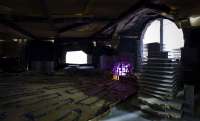Thistlegarden-project My plan is to create a garden consisting of only of wild thistles. Sown, but mainly re-planted from the wild in early spring, they will be placed in lines and patterns. The overall form will be a grafic representation of an explosion. In the heart of this pattern I want to create a pavilion made of scrapwood, found furniture, plexieglass and coloured glass. The garden is based on the famous formal gardens like the one that can be found for example in Versaille. While these formal garden used to reflect power and control, my thistlegarden will celebrate improvisation and question existing traditions, regulations and the organisation of modern society. The unwanted but beautifull plants are in a way anarchistic plants. They grow on places people do not want them there. They are hard to get rid of and know no boundaries spreading themselves by air. That the thistles are thus an ultimate metaphore for immigration and globalisation is easy to understand. After one season being placed in rigid lines, anarchie will start as they will spread their seeds and fluffs over the surrounding fields. In the previous years I did some research how to plant the thistles. For the most common annual thistles, replanting young sprouts in early spring is the best way to force them to grow in lines. Seeding those thistles is difficult. The larger biennial plants are much easier to sow. It is a rather ambitious project which I would like to realize in the coming 10 or 20 years during a biennial or outside a museum with suitable surroundings. In recent years, I have made some works both 2 and 3-dimensional in which I visualized and developed the idea. The 2 images I’ve send to AUP shows the first test-garden in 2001 and an interior-shot of an installation with a nightscene of the garden-plan. Rob Voerman, 2012
Thistlegarden-project My plan is to create a garden consisting of only of wild thistles. Sown, but mainly re-planted from the wild in early spring, they will be placed in lines and patterns. The overall form will be a grafic representation of an explosion. In the heart of this pattern I want to create a pavilion made of scrapwood, found furniture, plexieglass and coloured glass. The garden is based on the famous formal gardens like the one that can be found for example in Versaille. While these formal garden used to reflect power and control, my thistlegarden will celebrate improvisation and question existing traditions, regulations and the organisation of modern society. The unwanted but beautifull plants are in a way anarchistic plants. They grow on places people do not want them there. They are hard to get rid of and know no boundaries spreading themselves by air. That the thistles are thus an ultimate metaphore for immigration and globalisation is easy to understand. After one season being placed in rigid lines, anarchie will start as they will spread their seeds and fluffs over the surrounding fields. In the previous years I did some research how to plant the thistles. For the most common annual thistles, replanting young sprouts in early spring is the best way to force them to grow in lines. Seeding those thistles is difficult. The larger biennial plants are much easier to sow. It is a rather ambitious project which I would like to realize in the coming 10 or 20 years during a biennial or outside a museum with suitable surroundings. In recent years, I have made some works both 2 and 3-dimensional in which I visualized and developed the idea. The 2 images I’ve send to AUP shows the first test-garden in 2001 and an interior-shot of an installation with a nightscene of the garden-plan. Rob Voerman, 2012

